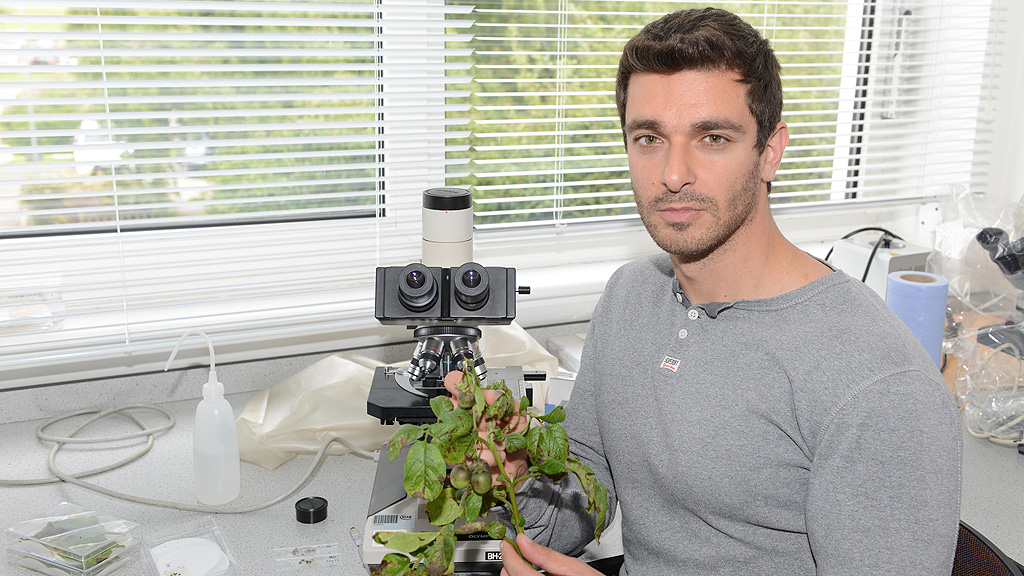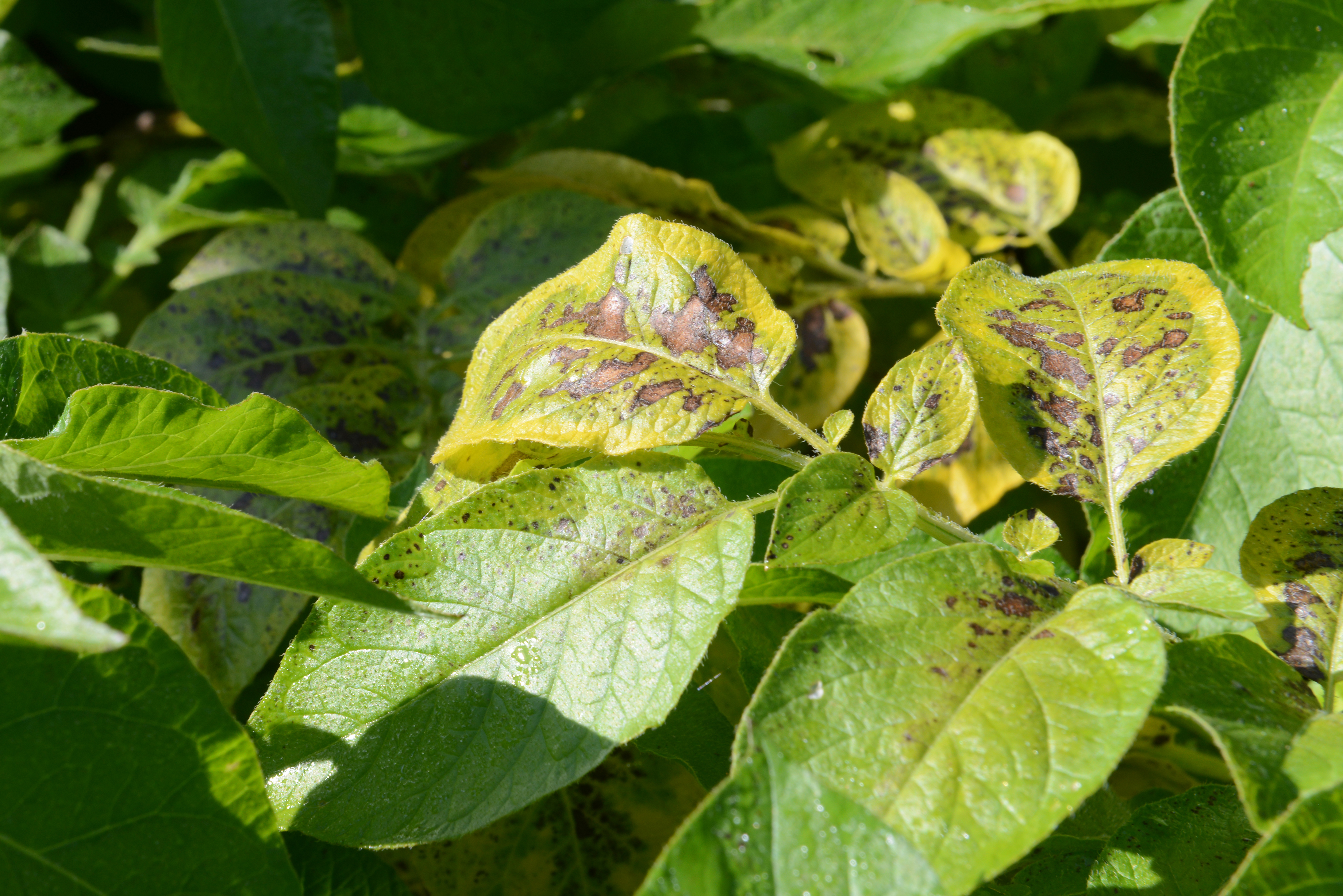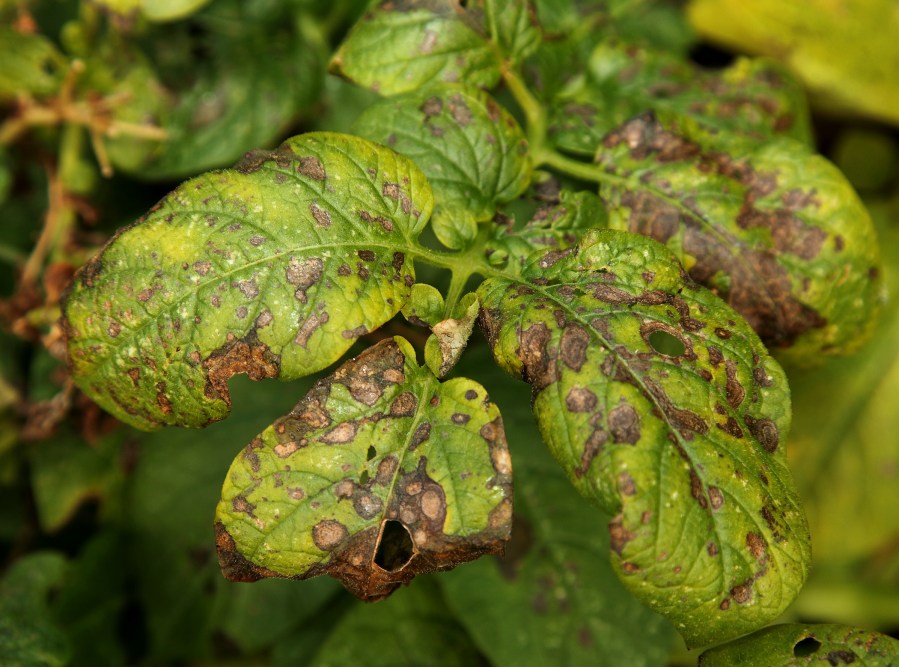A new study highlights the importance of correctly identifying early blight (target spot) in potatoes and finds the alternaria species responsible for producing the largest lesions are of most significance. CPM reports.
By Lucy de la Pasture
Many potato leaf symptoms that have historically been attributed to Alternaria alternata may in fact be something else. And even when the pathogen is present, it may not be having a significant impact on plant health or performance, according to new research by Ioannis Baltzakis at Wageningen University in the Netherlands and NIAB in the UK.
Assessing his latest results, Ioannis highlights the multitude of small black leaf spots that typically appear on the variety Markies, and the yellow-black necrotic leaf lesions frequently thought to be alternaria, are more likely to be due to nutrient deficiencies or other plant stresses.

Ioannis Baltzakis highlights the spotting often thought to be alternaria is more likely due to nutrient deficiencies or other plant stresses.
Testing of leaf samples in the trials frequently identified A. alternata on the leaf surface, but Ioannis believes this is hardly surprising since the pathogen is present in the air and is found in almost all environments to some extent.
The fact that delays may occur during transport to the lab and the cultivation of samples for testing can also skew the results, he points out.
Alternaria species
The A. alternata species could be so vigorous that it masks any other alternaria species that may be present, including Alternaria solani which is the more damaging strain infecting potatoes. To get a truly accurate picture of infection demands a molecular study of pathogen populations, he suggests.
Results of his recent research on both leaf tissue and whole plants also indicates A. alternata typically has little or no effect on potato crops. There’s also little causal relationship between it and the A. solani species, which can be more destructive of leaf material.
The trials showed clear differences between small spore alternaria species, including A. alternata, A. arborescens and A. infectoria, which produce relatively minor lesions, and those responsible for the large lesions which are of more concern to growers. This latter group includes A. solani, A. grandis and A. protenta.
Ioannis reports that in plot trials over the past three years, which includes UK work in the eastern counties in collaboration with Syngenta, infection occurs randomly across the field, indicating aerial inoculation.
Infection timing
“Once established in the crop, further spread by rain and localised splash would be more prevalent, especially with the larger-lesion strains, such as A. solani. Initial speculation that infection could be seed-borne had been unfounded judging from the trial results,” he adds.
“The crucial point for growers is the timing of initial plant infection with the large lesion strains. Extensive modelling of potato crop growth patterns has shown that plants often have the capability for compensatory growth that can mask disease effects. Where late alternaria infection occurs after the crop has begun to shut down, it may have little impact on final yield.”
Lab studies at Wageningen demonstrate the efficacy of both Amphore Plus (difenconaole+ mandipropamid) and Amistar (azoxystrobin) in preventing the development of alternaria assays. Difenoconazole appeared highly effective on both alternaria species, with azoxystrobin very good on A. solani but less robust on A. alternata.
“If A. alternata is not a serious problem, as the research suggests, this reduced efficacy really doesn’t matter, and with evidence of some residual activity it makes Amistar a good part of an overall strategy,” suggests Ioannis.
What to look for
Alternaria spp. can infect potato foliage at any time throughout the growing season. During the early season, developing lesions are more likely to occur on the oldest leaves, especially those leaves in contact with the soil surface or parts of a leaflet where free water collects, such as on cupped leaf margins.
Very often, Alternaria spp. will only be present at low levels until the onset of senescence, but in recent years the disease has been becoming of more significance earlier in the season. Once senescence has begun, lesions can become far more numerous.
Lesions can range from 1-15mm diameter, vary in colour from light brown to a dark grey/brown (with or without a yellow halo) and typically contain a pattern of concentric rings on the uppermost leaf surface, hence it’s also known as target spot.
Lesions are almost always randomly scattered over the compound leaf, although the first lesions are often seen where the leaf has been slow to dry. In contrast to late blight (Phytophthora infestans), lesions of Alternaria spp. are usually limited in their spread by leaf veins.

Suspected alternaria symptoms, but it’s impossible to tell with the naked eye.
Easily confused
Alternaria spp. symptoms can be easily confused with nutrient deficiencies and partially controlled lesions of late blight. Nutrient deficiencies usually show as regular, repeating symptoms, whereas spotting caused by the alternaria pathogens are randomly distributed across a compound leaf.
Although the two species of alternaria are generally indistinguishable in the field, A. alternata is considered to be the weaker pathogen and usually requires leaf senescence or a crop stress factor, such as a nutrient deficiency, drought or pest attack before high levels of disease can occur.
- solani may affect new, healthy leaf tissue and progress quickly through the haulm of a healthy, vigorous crop. Tuber infections are very rare and show as necrotic depressions close to the surface. This can be confused with gangrene or late blight.




